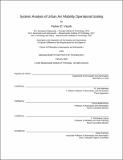Systems analysis of urban air mobility operational scaling
Author(s)
Vascik, Parker D.(Parker Denys Neff)
Download1199059939-MIT.pdf (20.43Mb)
Other Contributors
Massachusetts Institute of Technology. Department of Aeronautics and Astronautics.
Advisor
R. John Hansman.
Terms of use
Metadata
Show full item recordAbstract
Urban air mobility (UAM) refers to a set of vehicles and operational concepts that provide on-demand or scheduled air transportation services for passengers and cargo within a metropolitan area. Prior UAM systems based on helicopters or small aircraft did not achieve sustained, large-scale adoption. The goals of this thesis are: to identify the principal scaling constraints of UAM, to discern how the severity of these constraints varies with different implementation locations and operational concepts, and to assess the feasibility of large-scale UAM services in the United States subject to these constraints. Seven potential scaling constraints are identified through exploratory case studies of UAM operations in three U.S. cities. Of these constraints, the development of takeoff and landing areas (TOLAs) and the provision of air traffic control (ATC) services are proposed as principal near-term constraints and selected for detailed analysis. The development of high-throughput, small-footprint TOLAs to enable UAM scaling in urban areas is evaluated as a multicommodity flow problem. TOLA design and aircraft performance attributes that enhance throughput per footprint are determined through tradespace analysis. TOLA throughput is found to be highly dependent on attributes of ATC, namely controller workload and separation minima. Estimates of maximum aircraft throughput capacity are developed for representative inner-city UAM TOLAs of various physical designs. The development of procedurally segregated airspace cutouts for UAM flight is shown to be a promising strategy to enable high-volume UAM operations within terminal airspace. Furthermore, four flight procedures are proposed to support UAM access to commercial airports under both instrument flight rules (IFR) and visual flight rules (VFR). Lastly, the magnitude of ATC restrictions on the scale of UAM operations is evaluated in the 34 largest U.S. metropolitan areas. The degree to which ATC may constrain UAM scale is found to vary widely between these metropolitan areas potentially inhibiting service to over 75% of the population in the most restricted city but less than 15% in the least restricted city. The development of airspace cutouts for VFR UAM operations reduces this variation and increases population coverage from 65% to 80% in the median U.S. metropolitan area.
Description
This electronic version was submitted by the student author. The certified thesis is available in the Institute Archives and Special Collections. Thesis: Ph. D., Massachusetts Institute of Technology, Department of Aeronautics and Astronautics, 2020 Cataloged from the PDF of thesis. Includes bibliographical references (pages 195-205).
Date issued
2020Department
Massachusetts Institute of Technology. Department of Aeronautics and AstronauticsPublisher
Massachusetts Institute of Technology
Keywords
Aeronautics and Astronautics.